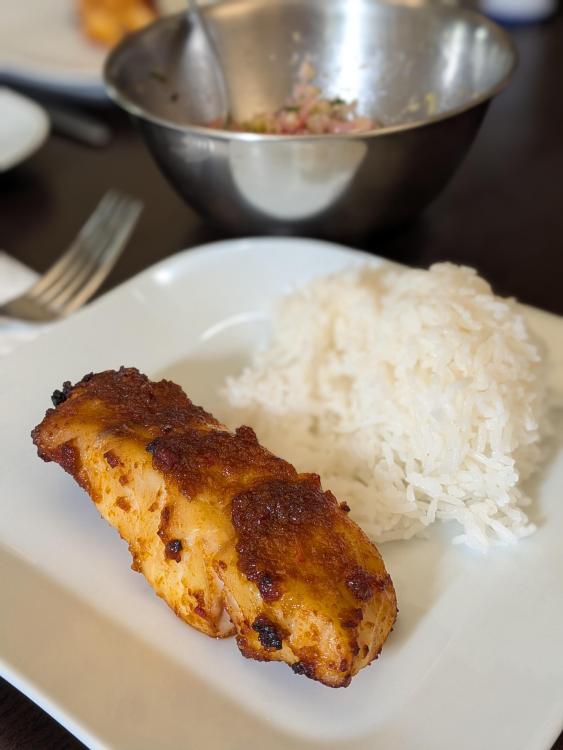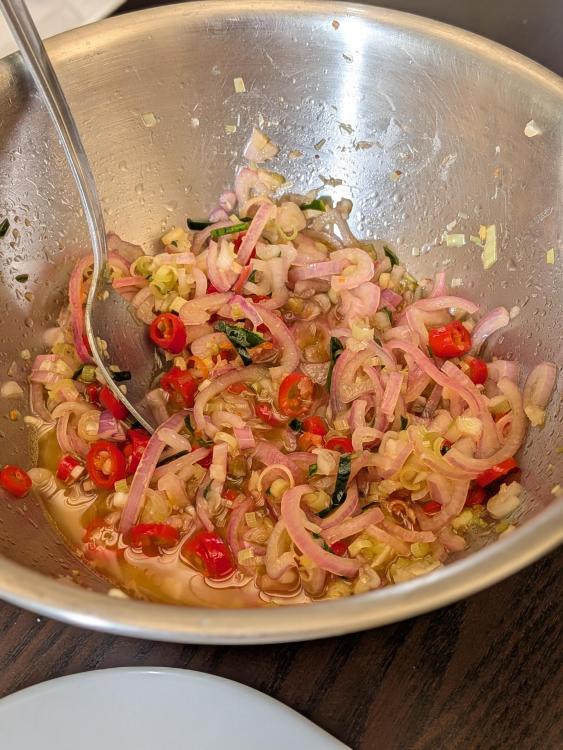
KennethT
participating member-
Posts
6,822 -
Joined
-
Last visited
About KennethT
- Currently Viewing Topic: Lunch 2025
Contact Methods
-
Website URL
http://
Profile Information
-
Location
New York, NY
Recent Profile Visitors
25,469 profile views
-
Do you have a Jaccard? It's a great tool, not only for tenderizing the meat, but quickly adding tons of skin punctures to help render the fat.
-
I haven't posted in this thread for a while... don't worry, we've stil been eating! I was all set to make our beloved Singapore Old Lai Huat style sambal grouper. The fish was completely defrosted when I found that I couldn't find any more sambal in the freezer! A freezer without that sambal is like a freezer without love... Anyway, I started panicking since I had no idea what to do with this fish that's now defrosted, and then I thought about an internet acquaintance of mine who was in Bali for the last few days. I realized that my pantry had everything I needed to make a Balinese style grilled fish (like we had on Jimbaran beach HERE)... so, without further ado... Jimbaran beach style grilled (air fryer) grouper Typical Balinese sambal matah made with home grown lemongrass, lime leaves and chillies.
-
[Un]truth in Food Advertising: Marketing vs. Reality
KennethT replied to a topic in Food Media & Arts
Yeah, that looks like quinoa to me also... -
I once saw a stir fried lettuce side dish in Singapore at our favorite chicken rice restaurant. We ordered it out of curiosity, along with a stir fried baby gailan (chinese broccoli) which is common in Singapore - although I've never seen it anywhere else. The stir fried lettuce was ok, but we much preferred the baby gailan.
-
Thank you, everyone! Exactly the answers I was looking for! Another +1 for EGullet!
-
Thanks @rotuts but I don't think I was clear. I'm not looking to make salt fish - like a bacalao or anything - just wondering whether presalting (maybe overnight like you would with chicken) is a good idea with meaty fish. I'm not trying to preserve it or anything - just looking for optimal texture.
-
Is it analogous to presalting a chicken or steak? I'm thinking about meaty chunks of grouper, tuna, swordfish, etc....
-
That place is awesome! I've had some great conversations with the owner. She wants me to sell her some of my kencur and home grown Indonesian chillies. As far as I know, they don't carry the beef skin crackers (I've looked for them before) but they do have pre-fried shrimp crackers and some other krupuk (they look like shrinky-dinks).
-
ooof, that's a shlep!
-
Interestingly, I think the kulit in krupuk kulit means leather also...In many parts of Java, a shadow puppet show called wayang kulit is very traditional. The puppets are made from leather and the shows typically depict a portion of, or sometimes the whole, Ramayana (which is really long) and is accompanied by a full gamelan orchestra.
-
Thanks everybody. I didn't think of Ottomanelli - I used to go there all the time but haven't in years. When I clicked on the Mercato link, it looked like it was coming from Ideal foods in Brooklyn... I think my first stop should be at a couple meat markets in Chinatown. I've never bought from Ends Meat but they probably would be a good resource since they deal with whole animals.
-
I've been thinking about making krupuk kulit - the unbelievably delicious and addictive puffed beef skin cracker common in Java (Indonesia) but have no idea where to get the fresh beef skin. Ideally, it's made from the softer, "inner skin" but I'm not even sure what that means.... I've looked at the Weee online grocer with no luck. I'd think Chinatown may have it, but I'd assume they have more pork products than beef ones... curious for any suggestions... Thanks!
-
I think the biggest problem with a fast release while braising would be the homogenization of the liquid fat (that has rendered out of the beef and would normally be floating on top) into the braising liquid.
-
What region is your tabbouli from? It has a lot more bulghur in it than I usually see. The Iraqi version my friend's mom used to make as well as the Jewish Moroccan version I've had have almost no bulghur by comparison - they're mostly green.
-
Now, see the new and improved version !!!!
- 1 reply
-
- 1
-


















